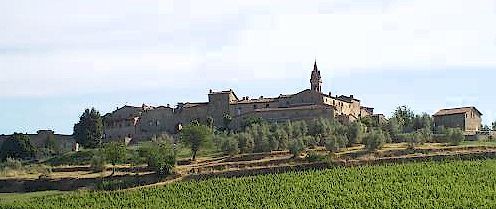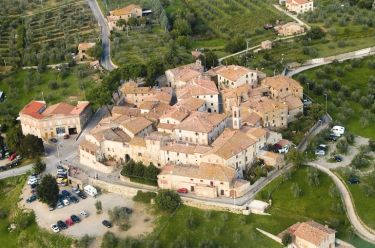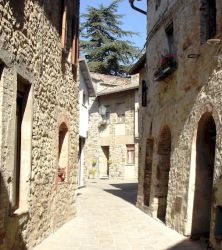San Gusmè

Village of San Gusmè
The village of San Gusmè lies on the road from Castelnuovo Berardenga to the Castle of Brolio. San Gusmè was originally a castle named after Sts. Cosmus and Damian, to whom the parish church is still dedicated. The first documentation of San Gusmè dates from the year 867, in the famous deed of the constitution of the Abbey of San Salvatore at Fontebuona which states that Wuinigi, Count of Sienna, and his wife, Richildadona, gave the Monastery of San Salvatore alla Berardenga some of his land situated at Campi and Sestano, including the Church of Santi Cosma e Damiano. The donation was confirmed in 881 by their sons, Berardo and Ranieri.
The Castle of San Gusmè later became the fief of Ranieri di Ricasoli, thanks to the Bishop of Magonza and Imperial Vicar in the year 1167. On 25 February 1554, a terrible battle was fought near the castle between the Siennese armies and the Austro-Spanish troops of the Emperor. However San Gusmè soon lost its autonomy and was eventually attached to the Grand Duchy of Tuscany. It was incorporated into the municipality of Castelnuovo Berardenga in 1777. Two gateways that gave access to the castle have been preserved in slightly modified form. The Siennese gateway is surmounted by a rectangular plaque in marble with the shield of Sienna between two leaves. In 1939, a third gateway was discovered. This is the Porta Nuova, which opens beside the side of the churche of Saints Cosma and Damiano. The churches of the Saints Cosma and Damiano and of the SS. Annunziata are situated inside the village.
Today San Gusmè is an example of a Chianti village that has managed to keep much of its ancient structure intact, with coats of arms placed above the arches, and its narrow houses and steeply winding streets.
On top of a nearby hill, a small group of farm houses and a small church are all that remain of the village of Campi. A little lower down, a few ruins mark the Castle of Sesta, nicknamed Sestaccia, bought in 1388 by the municipality of Siena from Farinata and Adriano Ubertini. The fortress, surrounded by an oval ring of city walls, has survived in reasonably good condition, but the remains of the walls consist of just a few stones protruding from the ground. Similarly, only a few elements, including the ruins of the entrance gate, remain today of the nearby Castle of Cetamura, which was once a fief of the Ricasoli family and which stands on the other side of the gorge of Ancherona. To the east of San Gusmè, we can also find the little that remains - now incorporated into a farm house - of what was probably once a Castle, known as the Palazzaccio.
Today San Gusmè is an example of a Chianti village that has managed to keep much of its ancient structure intact, with coats of arms placed above the arches, and its narrow houses and steeply winding streets.
On top of a nearby hill, a small group of farm houses and a small church are all that remain of the village of Campi. A little lower down, a few ruins mark the Castle of Sesta, nicknamed Sestaccia, bought in 1388 by the municipality of Siena from Farinata and Adriano Ubertini. The fortress, surrounded by an oval ring of city walls, has survived in reasonably good condition, but the remains of the walls consist of just a few stones protruding from the ground. Similarly, only a few elements, including the ruins of the entrance gate, remain today of the nearby Castle of Cetamura, which was once a fief of the Ricasoli family and which stands on the other side of the gorge of Ancherona. To the east of San Gusmè, we can also find the little that remains - now incorporated into a farm house - of what was probably once a Castle, known as the Palazzaccio.



